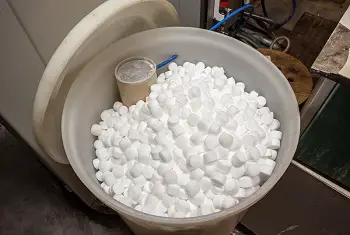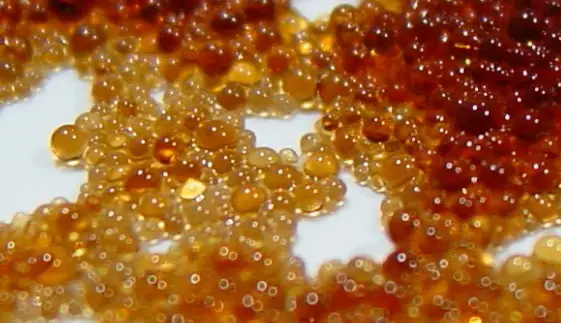I have been asked this question more times than I can remember. And this may sound like an easy question to answer, but the fact is, this is a much more complicated question than you may think. But let’s see if we can answer the question…
How Much Salt Does A Water Softener Use? A water softener will use approximately 1 pound of salt to remove 2,400 grains of hardness from its water softening resin. A water softener softening 75 gallons of water per day that has 10 grains of hardness per gallon will use 5 ounces of salt to remove the hardness accumulated per day.
Sound a bit confusing? Well, let’s see if I can explain it a little better.
Why does a water softener use salt?
A water softener uses saltwater to clear the hard minerals from the resin. Basically, the saltwater is the cleanser that removes hardness that has been removed from your water and rinses it away so that the resin can remove more hardness from the water.
How does a water softener use salt?

A water softener removes hard minerals from water by pulling them out of the water and holding them on its water softening resin.
This resin is basically little beads that hard minerals will cling to as the water passes over them. The problem is, eventually these beads become completely covered with hard minerals, and can not hold anymore.
A water softener flushes saltwater over the water softening resin which releases the hard minerals from the resin and carries them with the saltwater out to a drain.
How much hardness does your water softener have to remove?
The amount of hardness in the water being treated will make a difference in how much salt will be needed for the system to work correctly.
Water that contains a high amount of hardness should have a larger sized tank with a larger volume of resin in it. Naturally, the more resin needed to be cleaned, the more salt required to clean it.
How much resin does your water softener need to regenerate?
A small tank that is only 7 inches in diameter and 44 inches high, should only have 1/2 of a cubic foot of water softening resin in it.
A water softener of this size will normally need only about 6 pounds of salt per regeneration, where a larger system with a 13-inch diameter tank that is 54 inches high may need 15 pounds of salt to properly regenerate its softening resin.
Is there any iron in your water?
Iron in water can be removed by a water softener, but it needs to be handled a bit differently than hard minerals in the water.
The popular rule of thumb to remove iron from water is to treat every 1 Part Per Million (PPM) of iron as 4 grains of hardness. In other words, when setting your water softeners hardness level, add 4 to your water hardness for every 1 part per million of iron in your water.
Since having iron in your water will require you to raise the level of hardness in your water softener setting, the water softener will use a larger dose of salt to properly clean its water softening resin.
What kind of salt are you using?
Not all salt is created equal! Well, that’s not exactly true, the actual salt is the same in any water softener salt. The difference is, how pure the salt is, how it has been processed, and what has been added to it.
The purest water softener salt is called “solar” salt. This salt is 99% pure, with no additives, and no added chemicals. Because of this, it is also the most efficient salt. 99% of the salt crystal will be dissolved and usable for water softening resin regeneration.
Other salts like pellet salt work fine for most water softeners, but these pellets have a binder in them to make them into the pellet form. This binder does not dissolve in your water softener salt tank and will settle at the bottom of the tank.
This means that a percentage (although small) of the contents of the bag that you added to your salt tank will not be used in any way to help your system work better.
Water softener salts that contain iron remover of other additives that are intended to clean your system better, can make the actual salt less efficient, and therefore your systems resin will not get as fully regenerated as it would with salt that is purer.
That means that your water softener will have to use more of this salt to do the same job as solar salt that is 99% pure.
How efficient is your water softener?
When a water softener is brand new and set correctly, it will use just enough salt to regenerate its water softening resin as efficiently as it can.
Over time, iron or minerals in the water can build-up and clog the internal parts and waterways inside of the system. Using a water softener cleaning solution once every year can help to keep your water softeners insides cleaner, to keep it working efficiently.
But if there is any kind of build-up in your water softener, it may not be able to use its salt solution as well as it should.
This can mean having hard water and requiring a larger dose of salt for the system to regenerate its softening resin.
Properly setting your water softener, and keeping it clean on the inside with a simple water softener cleaner, will help it work better without using more salt than necessary.
How old is your water softener?
An older water softener that is more than 10 years old will have resin that may not be as effective as a new resin. Iron can build-up on the water softening resin, reducing the surface area available to remove hardness and iron from the water.
Chemicals like chlorine in your water which is often used to sanitize water coming from municipal water suppliers will damage the water softening resin and make it require more salt to properly lean it.
See my article on “Can Water Softener Resin Go Bad” for more details.
What type of resin does your water softener use?

Not all water softening systems use the same type of water softening resin.
Some resins are made for certain water situations, and although they may work very well, they may require more salt to get properly cleaned (regenerated).
If you have a water softener that is advertised to be very efficient, it may be referring to the amount of water used, and not the amount of salt used.
Some systems use a smaller size water softening resin in order to fit more resin into a certain amount of space.
The idea behind this is to create more surface area for water hardness removal and less saltwater needed for the same amount of surface area.
This often works very well to keep salt usage to a minimum, providing that you only need to remove hardness from your water.
If you have iron or excessive hardness in your water, these fine resins can develop a coating on them because the salt dosage is not strong enough and the water flow is not fast enough.
I only suggest high-efficiency water softeners for water with low hardness and no iron.
If you have very hard water or suspect that you might have iron in your water, a simple metered water softener will soften your water and remove iron with minimal salt used.
Is your water softener regenerating more than it needs to?
Properly setting the salt dosage and regeneration frequency can greatly reduce salt usage in a water softener.
A manually set water softener will use whatever salt dosage that it is set for as often as it is set for because it doesn’t know otherwise.
If your water softener regenerates by pre-set days, make sure that it is only regenerating as needed, and the hardness is not set higher than needed.
Many water softeners are pre-programmed to only regenerate when a certain amount of water has been used, and with a certain dose of salt.
You just have to make sure that the hardness is set correctly, and the water softeners computer will do the rest.
Does your water usage change?
If you have frequent guests or the kids coming home from school, your water softener will naturally need to use more salt to soften the higher volume of water being used.
If you only live in a home part of the year, you should make sure that the water softener is not using salt the same way as it does when you are using the home.
Some water softeners have a vacation mode to make sure that the system does not regenerate when you are away, if yours does not, you may want to bypass your water softener when you will not be using the home for an extended period of time.
A water softener needs to use salt to regenerate its water softening resin.
How much salt your water softener will use, depends on your water usage, and the characteristics of your water.
Make sure your system is working correctly and use a water softener cleaner once a year, to ensure your system is not using more salt than it needs to.


So is 40 pounds of solar salt crystals for a 2 person 2 bathroom home per month a lot?
We had our system rebuilt about 6 months ago which meant replacing the old resin as well as the “brain” as the old system was well over 30 years old.
It now seems to be using more than one 40 pound bag per month.
Hello Mr. Estes and thank you for the question.
Without knowing the characteristics of your water, I can’t say for sure how much salt would be needed for your situation, but even if your hardness is only moderate and your water is free of iron, your water softener may be using 8 or more pounds of salt each time it regenerates.
If your water softener regenerates about once per week (very common), that means that it would be using at least 32 pounds of salt per month so one 40 pound bag of salt per month is certainly not unheard of.
I hope this was helpful.
Paul
After installing the water softner, how much of run off is there that goes outside on the ground
If two adults are using the softened water?
Hello Reginald and thank you for the question.
Unfortunately, that is impossible for me to say. Your water characteristic and the capacity of the water softener will all have a bearing on how long a water softener regenerates and how much salt the water softener will discharge during each regeneration.
If you contact a local water treatment company near you that handles your brand of water softener, they should be able to test your water and make sure that the water softener is set correctly.
Once the water softener is set correctly, they should be able to tell you how long the water softener will discharge and how much salt it will be used for each regeneration.
I hope this was helpful!
Paul